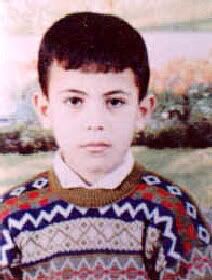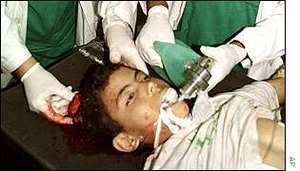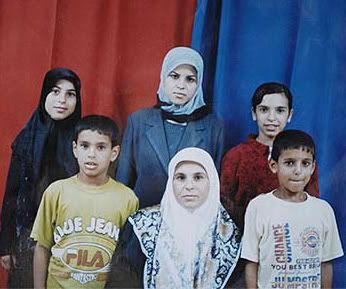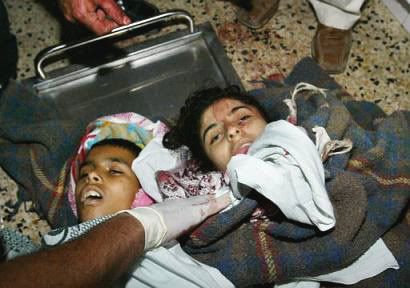…on the 60th anniversary of Israel’s independence.
Starting with the ethnic cleansing of the Palestinians from their ancestral lands in 1948, which entailed the killing of at least 10,000 civilians, the killing of Palestinians has continued, especially after the military occupations of the West Bank and Gaza in 1967, and the beginnings of their colonialism. The `intentional killing’ of Palestinian children during the first and second Intifadas is a particularly gruesome phase of Israeli militarism that is still going on, constituting as it does: state terrorism. Since Israel and the US State Department have broadened the definition of terrorism to include all conditions in which civilians are intentionally killed, the term `state terrorism’ deserves similar expansion: a state which intentionally kills civilians.
I am indebted to Lawrence of Cyberia for doing the legwork in pulling together this brief overview and permitting republication. Her article begins here:
“Liberal” Israelis: Still Crying And Shooting After All These Years
“Crying and shooting” is the term used in Israeli political discourse to describe those Israelis who agonize over what they are doing to the Palestinians, but carry on doing it anyway. It’s a way for Israelis to feel better about themselves, by reasserting their liberal, progressive and humanitarian values, even as they carry out illiberal, regressive and murderous actions.
There was a wonderful example of the phenomenon last week in a column written for Ha’aretz by Bradley Burston. He wrote an agonized column – Our Defense Forces, our war crimes, our terrorism – about the disproportionate number of civilians among the Palestinians killed by the IDF, and specifically about Israeli’s collective refusal to acknowledge their responsibility for the killings.
But his column is like one of those non-apologies you make when you know you should apologize for something, but you’re not really sorry. When instead of saying “I’m sorry for what I did”, you say “I’m sorry if you were offended”, as if it’s the offended feelings that are the problem, not the fact that you said something offensive in the first place.
The incident that set off Burston’s “soul-searching” was the killing of Myassar Abu Mu’attaq, and her four children – Rudayna (6) Hana (3), Saleh (4) and Mousad (15 months), photo left by Mohammed Abed for AFP – whose home was destroyed by an Israeli shell as the family sat down to breakfast.
(The IDF initially acknowledged the family had been killed by one of their tank shells which had gone off course, but subsequently claimed that they weren’t really responsible because although they had fired the shell, it had not really hit the house, but had struck instead two nearby Palestinian gunmen who were carrying large amounts of explosives that were detonated by the Israeli shell and indirectly blew up the Abu Mu’attaq house. This is a variant of the “Ghalia Defence” that the IDF came up with when it shelled a Gaza beach in June 2006, but denied any responsibility for the deaths of the Ghalia family who had been having a picnic there, claiming that although they fired six shells at the beach – one of which they could not account for – the errant shell could not have killed the Ghalia family who must have been killed instead by Palestinian munitions hidden under the sand that might have been inadvertantly detonated by the Israeli bombardment. That’s a close echo of what the IDF claims about the Abu Mu’attaq killings: the IDF knows it fired the shells, knows the civilians at the receiving end are dead, but subsequently introduces some intermediate mechanism – mines under the beach, exploding backpacks – that deflects responsibility to an intermediate agent, and allows the army that fires the shells to maintain the pretense that even when it kills civilians its intentions are pure. There’s probably a technical name in medical literature for this phenomenon of shifting blame for guilty actions to an intermediate party).
Anyway, on the surface, Bradley Burston’s column seems to be blowing the whistle on this self-righteous dissembling, calling the IDF’s actions “our war crimes”, “our terrorism”. But once you get past the title, you find he doesn’t really think it is a case of war crimes or terrorism at all. War crimes and terrorism imply an intention to kill the innocent, and Bradley Burston is certain there is never any such intention on the part of the IDF. It’s not that they want to kill civilians, you see, it’s just that in the imperfect world we live in, bad procedures and inaccurate weapons make them keep blowing up civilians again and again and again, whether they mean to or not:
We console ourselves, here on the Israeli side of the border, that, unlike the suicide bomber, the box cutter terrorist, the drive-by machine gunner, the Merkaz Harav gunman, the deaths of the children and their mother in Beit Hanoun were a terrible case of bad fortune.
We salve our doubts by stressing – and this is true – that the Israeli army never intentionally targets non-combatants. We protect our fragile consciences by suppressing case after case of Palestinian civilian casualties…
It would pay, in this regard, for us to recognize that despite cutting edge technology, we can aim neither tank shells nor missile with assurance.
The way we use them … kills children.
Bradley Burston wants you to know how bad he feels that his army keeps killing innocent Palestinians, but he doesn’t really want to take responsibility for the killings any more than the blame-shifting Israelis he criticizes in his article. He wants you to know he feels terrible about dead children – even the dead children of his enemy, see how liberal he is! – but he also wants you to believe that their deaths are essentially inadvertent, because the Israeli army never intentionally targets non-combatants.
What a load of rubbish.
The main reason why so many Palestinian civilians end up dead at the hands of Israel is not because the IDF uses as a matter of policy weapons that are unsuitable for policing a belligerent military occupation (although that is also true). The main reason so many Palestinian civilians end up dead is that individual Israeli soldiers (and occasionally settlers) deliberately shoot unarmed Palestinian civilians, and do so with impunity because they are protected by an IDF chain of command that issues shoot to kill orders and covers up the killings that result from them; by Israeli police who decline to investigate murder when the victim is “only” an Arab; by a judicial system that treats Israeli blood as sacred but Palestinian blood as worthless; and by an Israeli public that pretends it doesn’t know what is going on, and is aided and abetted in this phony, self-imposed ignorance by “liberal” commentators like Bradley Burston who assure them that the carnage beyond the wall is all some careless mistake.
Sorry to pop that comforting illusion for all you liberal criers and shooters, but most Palestinian civilians killed by the IDF are not killed by “errant” tank shells. They are killed by your sons who, while performing military service in support of the illegal occupation and colonization of Palestinian land that no country in the world recognizes as belonging to Israel, put unarmed civilians – even children – in their gun-sights, and shoot them dead. That’s what you and Bradley Burston should be crying into your beer over, not the occasionally unreliable trajectories of IDF tank shells.
Israel’s claim that its soldiers adhere to a doctrine of “purity of arms” in dealing with the Palestinian civilian population has been going on for a long time. In the first intifada, Ehud Barak was the IDF’s Deputy Chief of Staff, and proclaimed: “We do not want children to be shot under any circumstances … When you see a child you don’t shoot.” That was untrue then, just as Bradley Burston’s insinuation that Palestinian civilian deaths aren’t intentional is a lie now:
The Swedish “Save the Children” organization estimated that “23,600 to 29,900 children required medical treatment for their beating injuries in the first two years of the [first] intifida,” with nearly one‐third sustaining broken bones. Nearly one‐third of the beaten children were aged ten and under. It also states that 6,500 to 8,000 children were wounded by gunfire during the first two years of the Intifada. Researchers investigated 66 of the 106 recorded cases of “child gunshot deaths.” They concluded that: almost all of them “were hit by directed not random or ricochet gunfire”; nearly twenty percent suffered multiple gunshot wounds; twelve percent were shot from behind; fifteen percent of the children were ten years of age or younger; “most children were not participating in a stone throwing demonstration when shot dead”; and “nearly one fifth of the children were shot dead while at home or within ten meters of their homes.”
– cited in The Israel Lobby and US Foreign Policy (chapter 2, end note 49); by Mearsheimer and Walt.
That’s how the IDF killed Palestinian civilians – children – during the first intifada. Not through a careless use of missiles or the occasional errant tank shell, but by individual Israeli soldiers pointing their guns at children in the Occupied Territories – even children under ten, even children who had turned their backs and were running away – and shooting them dead.
And the IDF’s record in the second intifada is much worse. Firstly, because the IDF announced in March 2003 that it would no longer routinely investigate the deaths of civilians killed by Israeli soldiers, but would allow individual Israeli officers in the field to decide whether to call in the Military Police whenever their troops killed a civilian, or to simply declare the killing an “unfortunate incident of death”, which required no investigation. A policy that has had the following, entirely predictable, result:
The IDF effectively grants immunity to soldiers who open fire illegally. Since the beginning of the intifada, the IDF has ceased to automatically open an investigation into every case in which a Palestinian is killed by IDF fire. The decision as to whether to open a Military Police investigation into each incident is now made by the Judge Advocate General’s office, based on the results of the field de-briefings, which are also carried out by the army itself. In one case that was exposed by B’Tselem, it was clear that an eleven-year-old child had died as a result of the violation of procedures and illegal shooting. Despite this, the Judge Advocate General’s office decided not to request a Military Police investigation. In addition, the investigations that are opened are generally protracted and based primarily on soldiers’ testimonies, while completely ignoring the Palestinian eyewitnesses.
This policy has unavoidably resulted in a situation in which shooting at innocent Palestinians has practically become a routine. (B’Tselem)
And secondly, because at the very beginning of the second intifada, the IDF issued extremely broad open fire regulations, concerning who might be considered a legitimate target:
Sniper: “They forbid us to shoot at children”.
Journalist: “How do they say this?”
Sniper: “You don’t shoot a child who is 12 or younger”.
Journalist: “That is, a child of 12 or older is allowed?”
Sniper: “Twelve and up is allowed. He’s not a child anymore, he’s already after his bar mitzvah. Something like that”.
Journalist: “Thirteen is bar mitzvah age”.
Sniper: “Twelve and up, you’re allowed to shoot. That’s what they tell us”.
Journalist: “Under international law, a child is defined as someone up to the age of 18.”
Sniper: “Up until 18 is a child?”
Journalist: “So, according to the IDF, it is 12?”
Sniper: “According to what the IDF says to its soldiers. I don’t know if this is what the IDF says to the media.”Amira Hass’ interview with an IDF sharpshooter, explaining why so many Palestinian children were killed in the first weeks of the intifada, when the IDF was largely confronted by stonethrowers. Published in Ha’aretz, Don’t shoot till you can see they’re over the age of 12, 20 November 2000.
So, if you start off with an Israeli society that is generally convinced of its own perpetual victimhood and righteousness and of its enemies’ intrinsic wickedness, then draft young people from that society into the IDF, where you arm them, give them open fire regulations that allow them to shoot even at children, and assure them that as a matter of policy they will not be investigated for killing civilians… how surprising is it that the outcome during the second intifada has been this:
Reporting on a four-year field study in occupied Palestine for the British Medical Journal, Dr Derek Summerfield wrote that “two-thirds of the 621 children killed at checkpoints, in the street, on the way to school, in their homes, died from small arms fire, directed in over half of cases to the head, neck and chest – the sniper’s wound”.
These Palestinian children are not being killed by errant tank shells, they are being shot by Israeli soldiers. And the soldiers who are shooting them are not just “a few bad apples”, but are acting within the norms of an Israeli army that fosters at every level in the chain of command the belief that it is perfectly natural for an Israeli soldier to kill a Palestinian civilian without fear of repercussions. You can see this culture of impunity at work in some real life examples.
Eleven-year-old Khalil al-Mughrabi (pictured above, family photo via B’Tselem) was playing soccer with two friends in Rafah on 7 July 2001, when an Israeli soldier opened fire on them with a heavy-caliber tank-mounted machine gun. Khalil was shot in the head and killed. His two friends (aged 10 and 12) were seriously wounded. Eyewitnesses said there was no unrest in the area when the Israeli soldier opened fire on the children, and B’Tselem, the Israeli civil rights group, asked the IDF to open a criminal investigation.
When the Chief Military Prosecutor (Colonel Einat Ron) eventually responded to researchers at B’Tselem, she informed them there was no reason to open a criminal investigation, as she had found that the soldiers had acted properly, opening fire when confronted by rioters. Unfortunately for Col. Dan, the supporting documents that her office sent to B’Tselem inadvertently included internal army documents, never intended for release to the public, showing that Col. Dan had actually found there was no riot going on at the time Khalil was shot, that his killing was unjustified, and that she had experimented with various phony explanations for B’Tselem before settling on the “killed in a riot” scenario:
The case of Khalil al-Mughrabi is telling. The 11-year-old was shot dead in Rafah by the Israeli army two years ago as he played football with a group of friends near the security fence. One of Israel’s most respected human rights organisations, B’Tselem, wrote to the judge advocate general’s office, responsible for prosecuting soldiers, demanding an inquiry. Months later, the office wrote back saying that Khalil was shot by soldiers who acted with “restraint and control” to disperse a riot in the area. However, the judge advocate general’s office made the mistake of attaching a copy of its own, supposedly secret, investigation which came to a quite different conclusion – that the riot had been much earlier in the day and the soldiers who shot the child should not have opened fire. The report says a “serious deviation from obligatory norms of behaviour” took place.
In the report, the chief military prosecutor, Colonel Einat Ron, then spelled out alternative false scenarios that should be offered to B’Tselem. B’Tselem said the internal report confirmed that the army has a policy of covering up its crimes. “The message that the judge advocate general’s office transmits to soldiers is clear: soldiers who violate the ‘Open Fire Regulations’, even if their breach results in death, will not be investigated and will not be prosecuted.”
And the IDF’s role in the deliberate killing of unarmed civilians is by no means limited to covering up after the event for individual murderers in its ranks. Meet the Mughayer family, including 16-year-old Asma (in the back row, on the left of this photo) and her 13-year-old brother, Ahmed (directly in front of her):
Asma and Ahmed Mughayer were shot dead while hanging out laundry on the roof of their home in Rafah, on the morning that the IDF launched a major attack (“Operation Rainbow”) on the Tel al-Sultan refugee camp where they lived, on 18 May 2004. The IDF said of their deaths: “A preliminary investigation indicates they were killed by a bomb intended to be used against soldiers. It was set outside a building by Palestinians to hit an Israeli vehicle”. But the Mughayer family said that the children had not been killed by a bomb, but shot by an Israeli sniper, operating out of a neighboring building. An Australian journalist visited the Mughayer house, and found no signs of an explosion there, though he did find bullet holes on the roof, made by bullets which seemed to have been fired from the neighboring building. He visited the neighboring building, and found that its occupants had been held prisoner by an Israeli sniper team that had operated out of their house on the morning that Asma and Ahmed were killed, and left behind MRE wrappers and ammunition boxes (labelled in Hebrew) . British journalists who examined the children’s bodies at the morgue found no signs of injuries except for a single bullet hole through the head.
After the British and Australian journalists published their findings, the IDF announced it would hold an internal investigation into the death of the Mughayer siblings. But six months later, while world attention was distracted by a new, large-scale invasion of the Gaza Strip refugee camps, the IDF quietly dropped its investigation. The following year, some of the soldiers who took part in Operation Rainbow gave their testimonies to the Breaking the Silence exhibition. They testified that they had killed innocent Palestinian civilians, under orders from their superiors to kill any Palestinian they encountered, armed or not. They were concerned, in retrospect, that they were guilty of carrying out illegal orders, and one of them knew what had happened in the specific case of Asma and Ahmed Mughayer, whom the IDF assured us were blown up by a Palestinian bomb:
According to Rafi, an officer in the Shaldag, an elite unit connected to the air force, the whole mission was about revenge. “The commanders said kill as many people as possible,” he said.
He and his men were ordered to shoot anyone who appeared to be touching the ground, as if they might be placing a roadside bomb, or anyone seen on a roof or a balcony, as if they might be observing Israeli forces for military reasons, regardless of whether they were armed.
Asma Moghayyer, 16, and her brother Ahmed, 13, were shot as they went to collect clothes from a rooftop washing line. The Israeli army insisted the children had been blown up by a roadside bomb. However, journalists visiting the morgue saw only single bullet wounds to the head.
The truth, said Rafi, was that they were shot by an Israeli soldier following clear orders to shoot anyone on a roof regardless of their role in the conflict.
Rafi says that his overriding impression of the operation was “chaos” and the “indiscriminate use of force”. “Gaza was considered a playground for sharpshooters.”
Israeli Soldiers Tell of Indiscriminate Killings by Army and a Culture of Impunity by Conal Urquhart; 6 Sept 2005.
This is why more than half the people killed by the IDF in the second intifada have been civilians, and about one-third of those children, killed in disproportionate numbers by gunshots to the head and upper body. Some of them – like the Mughayer children, and probably Dalal al-Sabagh, and Jihad al-Natur, Hani Qandul, Fathi Bulbul, Ibriz al-Minawi and Ala Adawiya (link) – were shot by Israeli soldiers who were following the illegal orders of superior officers who told them to shoot even unarmed civilians. Others – like Khalil al-Mughrabi, or Shaden Abu Hijla and Ahmed al Karini (link), or Mansour Tahah Sayed Ahmad, were shot by soldiers who killed unarmed civilians without having to be ordered to, safe in the knowledge that whatever they did to a Palestinian civilian would be covered up by their commanders after the fact. Either way, they were not killed by errant shells or well-meaning soldiers who made a poor choice of weaponry, as Bradley Burston would like you to think.
There is a deep lack of honesty in publicly agonizing over the number of innocent civilians killed by the IDF, while suggesting at the same time that the primary cause of their deaths is the manner in which a well-meaning Israeli army uses its shells and missiles. It falsely implies that most of the civilians the IDF kills are killed inadvertently and indirectly. It allows Bradley Burston and his readers to avoid having to confront the fact that although dropping shells and missiles in Palestinian residential areas causes terrible civilian casualties (and it does; I am not minimizing for one moment the horror of the highly-publicized atrocities in which Israeli shells have wiped out entire Palestinian families like the Abu Mu’attaqs, the Ghalias and the al-‘Athamnas), most civilians killed by the IDF don’t die this way, but are shot by Israeli soldiers. Instead of being a genuine mea culpa, evasions like Bradley Burston’s column become just another layer in the cover-up that allows Israelis to deceive themselves and the rest of the world about what they are doing to Palestinian people in the Occupied Territories. Personally, I would rather hear from unrepentant rightists who know Israeli soldiers shoot civilians and defend it unapologetically on the grounds that ‘it’s them or us’ or ‘they all grow up to be terrorists anyway’. Obviously I don’t agree with them. I think they’re wrong, and I think they’re disgusting, but I think too that at least they’re honest, which is more than I can say about crying and shooting “liberals”.
End of article. Links to evidence supporting the material presented above can be found in the original article.









